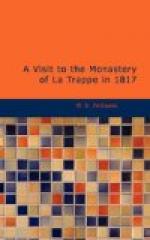[Footnote 14: According to Mezeray, this palace had its name from the spot whereon it is situated, which was called Les Tuilleries, because tiles (des tuiles) were made here. Catherine de Medicis built it 1564. It consisted of nothing but the large square pavilion in the middle, the two wings, and the two pavilions which terminate the wings. Henry IV. Louis XIII. and Louis XIV. afterwards extended, elevated, and embellished it. It is said to be neither so well proportioned, so beautiful, or so regular, as it was at first. The Tuilleries is, nevertheless, a very splendid palace. An astrologer having predicted to Catherine de Medicis, that she would die near St. Germain, she immediately flew, in a most superstitious manner, from all places and churches that bore this name; she no more resorted to St. Germain-en-Laye, and because her palace of the Tuilleries was situated in the parish of Saint Germain l’Auxerrois, she was at the expense of building another, which was the Hotel de Soissons, near the church of St. Eustache. When it was known to be Laurence de Saint Germain, Bishop of Nazareth, who had attended her upon her death-bed, people infatuated with astrology averred that the prediction had been accomplished.]
[Footnote 15: Henri IV se plaisait beaucoup a Saint-Germain, et y vint souvent, quand son coeur fut epris des charmes de la belle Gabrielle. Ce prince galant et liberal, qui deja lui avait prouve son amour par le don d’une infinite de maisons de campagne, aux environs de Paris, voulut encore lui donner une preuve de sa tendresse, en batissant pour elle, a deux cents toises de l’ancien chateau, une nouvelle et belle habitation, qu’on appela le Chateau Neuf. Eleve sur les dessins de l’architecte Marchand, il etait surtout remarquable par son architecture simple, ses nombreuses devises, les chiffres amoureux et les emblemes allegoriques qui le decoroient, et qui faisoient une ingenieuse allusion a la passion du monarque pour sa maitresse. L’une des ailes de ce chateau s’appelait meme le Pavillon de Gabrielle.—Hist. Topo. des Environs de Paris.]
The City of Paris is seen in the distance. The fine aqueduct of Marly, the mountain de Coeur volant, Mount Calvary,[16] and Malmaison to the right; in front the forest of Vesinet, and beyond it the vale of Saint Denis; on the left the hills which encompass the beautiful vale of Montmorency; the Seine winding at the foot, and extending its course until it loses itself in the distance—all within one sweep of the eye!—Such is the enchanting prospect which presents itself.




